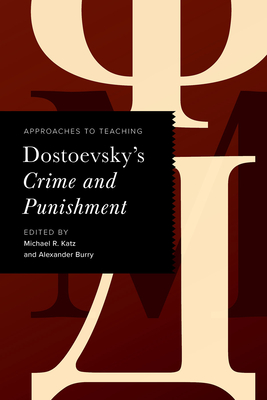Approaches to Teaching Dostoevsky's Crime and Punishment

Approaches to Teaching Dostoevsky's Crime and Punishment
Recounting the murder of an elderly woman by a student expelled from university, Crime and Punishment is a psychological and political novel that portrays the strains on Russian society in the middle of the nineteenth century. Its protagonist, Raskolnikov, moves in a world of dire poverty, disillusionment, radicalism, and nihilism interwoven with religious faith and utopianism. In Dostoevsky's innovative style, which he called fantastic realism, the narrator frequently reports from within the protagonist's mind. The depiction of the desperate lives of tradespeople, students, alcoholics, prostitutes, and criminals gives readers insight into the urban society of St. Petersburg at the time.The first part of this book offers instructors guidance on editions and translations, a map of St. Petersburg showing locations mentioned in the novel, a list of characters and an explanation of the Russian naming system, and recommendations for further reading. In the second part, essays analyze key scenes, address many of Dostoevsky's themes, and consider the roles of ethics, gender, money, Orthodox Christianity, and social justice in the narrative. The volume concludes with essays on digital media, film adaptations, and questions of translation.
407.49Lei
407.49Lei
Livrare in 2-4 saptamani
Descrierea produsului
Recounting the murder of an elderly woman by a student expelled from university, Crime and Punishment is a psychological and political novel that portrays the strains on Russian society in the middle of the nineteenth century. Its protagonist, Raskolnikov, moves in a world of dire poverty, disillusionment, radicalism, and nihilism interwoven with religious faith and utopianism. In Dostoevsky's innovative style, which he called fantastic realism, the narrator frequently reports from within the protagonist's mind. The depiction of the desperate lives of tradespeople, students, alcoholics, prostitutes, and criminals gives readers insight into the urban society of St. Petersburg at the time.The first part of this book offers instructors guidance on editions and translations, a map of St. Petersburg showing locations mentioned in the novel, a list of characters and an explanation of the Russian naming system, and recommendations for further reading. In the second part, essays analyze key scenes, address many of Dostoevsky's themes, and consider the roles of ethics, gender, money, Orthodox Christianity, and social justice in the narrative. The volume concludes with essays on digital media, film adaptations, and questions of translation.
Detaliile produsului










